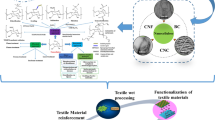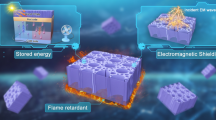Abstract
Cellulose-based composites typically have poor water resistance because they are cross-linked through non-covalent bonds, such as hydrogen bonds. Herein, furan group was grafted onto sisal microcrystalline cellulose fiber (F-MSF) and a dynamic thermally reversible cross-linked network structure was formed with maleimide modified CaCu3Ti4O12 (D-CCTO) to obtain recyclable D-CCTO/F-MSF composites (DFF) through the Diels-Alder reaction. The results showed that the mechanical properties of DFF composites were improved due to the improvement of the cross-linked structure between D-CCTO and F-MSF. At 1 wt% D-CCTO content, the tensile strength of DFF was 5.53 MPa, which increased by 346% compared with that of pure MSF. At 5 wt% D-CCTO content, the short-circuit current, open circuit voltage, transferred charge of DFF-based triboelectric nanogenerators (DF-TENG) were 3.2 µA, 85 V and 26 nC, respectively. Additionally, the DF-TENG was able to maintain its electrical performance of more than 60% at an ambient humidity of 90% and was able to light up more than 30 LED bulbs. This research provides new insights into addressing the challenge of poor water resistance in conventional cellulose-based composites, while also designing a recyclable TENG device that can harvest energy in high humidity environments.
Graphical abstract







Similar content being viewed by others
Data availability
Data will be made available on request.
References
Chapelle C, Quienne B, Bonneaud C, David G, Caillol S (2021) Diels–Alder–Chitosan based dissociative covalent adaptable networks. Carbohydr Polym 253:117222. https://doi.org/10.1016/j.carbpol.2020.117222
Chen X, Ouyang Y, Liu X, Ruan H, Xu X, Lu S, Li Y (2022) Dynamic covalent-crosslinked furan-modified CaCu3Ti4O12/polyurethane composite-based triboelectric nanogenerator and its application in self-powered cathodic protection. J Mater Sci Mater El 33(29):22773–22784. https://doi.org/10.1007/s10854-022-09045-4
Chen S, Jiang GY, Zhou JH, Wang G, Zhu Y, Cheng WK, Yu HP (2023) Robust solvatochromic gels for self-defensive smart windows. Adv Funct Mater. https://doi.org/10.1002/adfm.202214382
Coe JM, Antonelis GB, Moy K (2019) Taking control of persistent solid waste pollution. Mar Pollut Bull 139:105–110. https://doi.org/10.1016/j.marpolbul.2018.12.004
Fatma B, Gupta S, Chatterjee C, Bhunia R, Verma V, Garg A (2020) Triboelectric generators made of mechanically robust PVDF films as self-powered autonomous sensors for wireless transmission based remote security systems. J Mater Chem A 8(30):15023–15033. https://doi.org/10.1039/d0ta04716c
Fatma B, Andrabi SM, Gupta S, Kumar A, Verma V, Pitsalidis C, Garg A (2023) Biocompatible, breathable and degradable microbial cellulose based triboelectric nanogenerator for wearable transient electronics. Nano Energy 114:108628. https://doi.org/10.1016/j.nanoen.2023.108628
Feng Y, Dong Y, Zhang L, Li X, Li L, Zheng Y, Liu W (2021) Green plant-based triboelectricity system for green energy harvesting and contact warning. EcoMat 3(6):e12145. https://doi.org/10.1002/eom2.12145
Gao S, Zeng X, Zhang G, Zhang J, Chen Y, Wang ZL (2022) Triboelectric–electromagnetic hybridized module for energy harvesting of power transmission lines galloping and self-powered galloping state monitoring. Nano Energy 101:107530. https://doi.org/10.1016/j.nanoen.2022.107530
Ghayebzadeh M, Aslani H, Taghipour H, Mousavi S (2020) Estimation of plastic waste inputs from land into the Caspian sea: a significant unseen marine pollution. Mar Pollut Bull 151:110871. https://doi.org/10.1016/j.marpolbul.2019.110871
Guney MS (2016) Solar power and application methods. Renew Sust Energ Rev 57:776–785. https://doi.org/10.1016/j.rser.2015.12.055
Hu S, Han J, Shi Z, Chen K, Xu N, Wang Y (2022) Biodegradable, super-strong, and conductive cellulose macrofibers for fabric-based triboelectric nanogenerator. Nanomicro Lett 14(1):115. https://doi.org/10.1007/s40820-022-00858-w
Hu T, Wang H, Harmon W, Bamgboje D, Wang ZL (2022) Current progress on Power Management Systems for Triboelectric Nanogenerators. IEEE T Power Electr 37(8):9850–9864. https://doi.org/10.1109/tpel.2022.3156871
Jeong CK, Baek KM, Niu S, Nam TW, Hur YH, Park DY (2014) Topographically-designed triboelectric nanogenerator via block copolymer self-assembly. Nano Lett 14(12):7031–7038. https://doi.org/10.1021/nl503402c
Jiang GY, Wang G, Zhu Y, Cheng WK, Cao KY, Xu GW, Yu HP (2022) A scalable bacterial cellulose ionogel for multisensory electronic skin. Research. https://doi.org/10.34133/2022/9814767
Kim I, Jeon H, Kim D, You J, Kim D (2018) All-in-one cellulose based triboelectric nanogenerator for electronic paper using simple filtration process. Nano Energy 53:975–981. https://doi.org/10.1016/j.nanoen.2018.09.060
Kim J, Ryu H, Lee JH, Khan U, Kwak SS, Yoon HJ, Kim SW (2020) High permittivity CaCu3Ti4O12 particle-induced internal polarization amplification for high performance triboelectric nanogenerators. Adv Energy Mater 10(9):1903524. https://doi.org/10.1002/aenm.201903524
Li Z, Siddiqi A, Anadon LD, Narayanamurti V (2018) Towards sustainability in water-energy nexus: ocean energy for seawater desalination. Renew Sust Energ Rev 82:3833–3847. https://doi.org/10.1016/j.rser.2017.10.087
Li Y, Zhao Z, Gao Y, Li S, Zhou L, Wang J (2021) Low-cost, environmentally friendly, and high-performance triboelectric nanogenerator based on a common waste material. ACS Appl Mater Interfaces 13(26):30776–30784. https://doi.org/10.1021/acsami.1c09192
Liang S, Wang Y, Liu Q, Yuan T, Yao C (2021) The recent progress in Cellulose Paper-based Triboelectric Nanogenerators. Adv Sustain Syst 5(6):2100034. https://doi.org/10.1002/adsu.202100034
Midilli A, Dincer I, Rosen MA (2007) The role and future benefits of green energy. Int J Green Energy 4(1):65–87. https://doi.org/10.1080/15435070601015494
Nie S, Cai C, Lin X, Zhang C, Lu Y, Mo J, Wang S (2020) Chemically functionalized cellulose nanofibrils for improving triboelectric charge density of a triboelectric nanogenerator. ACS Sustain Chem Eng 8(50):18678–18685. https://doi.org/10.1021/acssuschemeng.0c07531
Nie S, Fu Q, Lin X, Zhang C, Lu Y, Wang S (2021) Enhanced performance of a cellulose nanofibrils-based triboelectric nanogenerator by tuning the surface polarizability and hydrophobicity. Chem Eng J 404:126512. https://doi.org/10.1016/j.cej.2020.126512
Niu S, Zhou YS, Wang S, Liu Y, Lin L, Bando Y, Wang ZL (2014) Simulation method for optimizing the performance of an integrated triboelectric nanogenerator energy harvesting system. Nano Energy 8:150–156. https://doi.org/10.1016/j.nanoen.2014.05.018
Rosenberg E, Lind A, Espegren KA (2013) The impact of future energy demand on renewable energy production-case of Norway. Energy 61:419–431. https://doi.org/10.1016/j.energy.2013.08.044
Shimoda Y, Yamaguchi Y, Iwafune Y, Hidaka K, Meier A, Yagita Y (2020) Energy demand science for a decarbonized society in the context of the residential sector. Renew Sust Energ Rev 132:110051. https://doi.org/10.1016/j.rser.2020.110051
Si J, Duan R, Zhang M, Liu X (2022) Recent progress regarding materials and structures of triboelectric nanogenerators for AR and VR. Nanomaterials 12(8):1385. https://doi.org/10.3390/nano12081385
Song YH, Liu M, Bao JK, Hu Y, Xu MH, Yang ZB, Shi ZQ (2022) TOCN/copper calcium titanate composite aerogel films as high-performance triboelectric materials for energy harvesting. Carbohyd Polym 298:120111. https://doi.org/10.1016/j.carbpol.2022.120111
Uchino K (2018) Piezoelectric energy harvesting systems—essentials to successful developments. Energy Technol 6(5):829–848. https://doi.org/10.1002/ente.201700785
Van de Graaf T, Colgan JD (2017) Russian gas games or well-oiled conflict? Energy security and the 2014 Ukraine crisis. Energy Res Soc Sci 24:59–64. https://doi.org/10.1016/j.erss.2016.12.018
Xie Y, Wang S, Niu S, Lin L, Jing Q, Yang J (2014) Grating-structured freestanding triboelectric-layer nanogenerator for harvesting mechanical energy at 85% total conversion efficiency. Adv Mater 26(38):6599–6607. https://doi.org/10.1002/adma.201402428
Yoshioka S, Aoyama H, Fujioka H, Arisawa M (2018) Cascade multiple Diels–Alder reactions of styrene derivatives with maleimide or maleic anhydride. J Org Chem 83(12):6599–6606. https://doi.org/10.1021/acs.joc.8b00890
Zhang M, Du H, Liu K, Nie S, Xu T, Zhang X, Si C (2021) Fabrication and applications of cellulose-based nanogenerators. Adv Compos Hybrid Mater 4(4):865–884. https://doi.org/10.1007/s42114-021-00312-2
Zhang S, Chi MC, Mo JL, Liu T, Liu YH, Fu Q, Nie SX (2022) Bioinspired asymmetric amphiphilic surface for triboelectric enhanced efficient water harvesting. Nat Commun 13(1):4168. https://doi.org/10.1038/s41467-022-31987-w
Zhao Z, Zhou L, Li S, Liu D, Li Y, Gao Y (2021) Selection rules of triboelectric materials for direct-current triboelectric nanogenerator. Nat Commun 12(1):4686. https://doi.org/10.1038/s41467-021-25046-z
Zheng C-W, Xiao Z-N, Peng Y-H, Li C-Y, Du Z-B (2018) Rezoning global offshore wind energy resources. Renew Energy 129:1–11. https://doi.org/10.1038/s41467-021-25046-z
Zhu Q, Wang T, Sun X, Wei Y, Zhang S, Wang X, Luo L (2022) Effects of fluorine-based modification on triboelectric properties of cellulose. Polymers 14(17):3536. https://doi.org/10.3390/polym14173536
Zhu Y, Guo Y, Cao K, Zeng S, Jiang G, Liu Y, Yu G (2023) A general strategy for synthesizing biomacromolecular ionogel membranes via solvent-induced self-assembly. Nat Synth. https://doi.org/10.1038/s44160-023-00315-5
Acknowledgments
The authors gratefully acknowledge the financial support of the Natural Science Foundation of Guangxi Province (2022GXNSFAA035536), the Innovation Project of Guangxi Graduate Education (YCBZ2022120), and the Key Laboratory of New Processing Technology for Nonferrous Metal and Materials, Ministry of Education (22KF-7).
Author information
Authors and Affiliations
Contributions
Hong Ruan: Conceptualization, Writing-review & editing, Investigation. Xin Chen: Methodology, Investigation, Writing-original draft. Chunzi Lv: Writing-review & editing, Visualization. Xingshuai Gu: Writing-review & editing, Visualization. Zhijian Zhou: Writing-review & editing. Shaorong Lu: Supervision, Writing-review & editing. Yuqi Li: Supervision, Writing-review & editing, Project administration.
Corresponding author
Ethics declarations
Conflict of interest
The authors declare no conflict of interest.
Ethics approval and consent to participate
Not applicable.
Consent for publication
All authors agreed with the content and that all gave explicit consent for publication.
Additional information
Publisher’s Note
Springer Nature remains neutral with regard to jurisdictional claims in published maps and institutional affiliations.
Supplementary Information
Below is the link to the electronic supplementary material.
Supplementary file2 (MP4 1678 kb)
Supplementary file3 (MP4 14632 kb)
Rights and permissions
Springer Nature or its licensor (e.g. a society or other partner) holds exclusive rights to this article under a publishing agreement with the author(s) or other rightsholder(s); author self-archiving of the accepted manuscript version of this article is solely governed by the terms of such publishing agreement and applicable law.
About this article
Cite this article
Ruan, H., Chen, X., Lv, C. et al. Water-durable, and recyclable dynamic cross-linked cellulose-based triboelectric nanogenerators for energy harvesting. Cellulose 30, 11425–11437 (2023). https://doi.org/10.1007/s10570-023-05568-z
Received:
Accepted:
Published:
Issue Date:
DOI: https://doi.org/10.1007/s10570-023-05568-z




